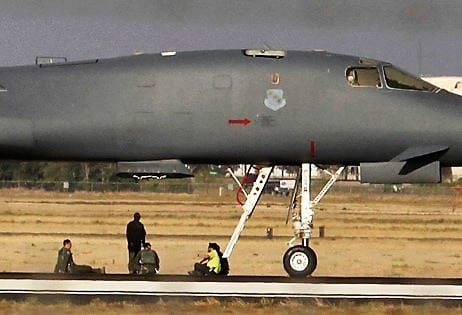WASHINGTON — The U.S. Air Force is making changes to the way it sustains the B-1B Lancer bomber and C-5 Super Galaxy cargo plane, moving to a maintenance approach that will allow it to use data analytics to predict problems, the acting head of Air Force Materiel Command said.
Both the B-1 and C-5 fleets transitioned to a conditions-based maintenance model last month, Lt. Gen. Robert McMurry, commander of the Air Force Life Cycle Management Center, told Defense News in a Sept. 18 interview.
“Given the aging fleet situation that we have, we probably need to be using data better to take care of it — which is a drive toward what most everyone right now is saying is the right way to manage fleet sustainment, which is through condition-based maintenance and data analytics,” he said. “So we’re trying to bring that on.”
The approach — which involves using algorithms to predict the need for repairs rather than waiting for a part to break — is a standard practice in the commercial airline industry to help reduce maintenance-related delays or cancellations, but has been less common in the Air Force.
RELATED

AFMC determined it needed to make a greater push toward conditions-based maintenance as a result of servicewide reviews triggered by rising concerns about the number of aviation-related mishaps.
The first review, directed by Air Force Chief of Staff Gen. Dave Goldfein, involved a one-day standdown that would give flying and maintenance units a chance to communicate potential safety concerns up the chain of command. Gen. Ellen Pawlikowski, then the head of AFMC, also directed the organizations under her command, like the Air Force Sustaiment Center, to evaluate its own data.
The reviews have since concluded, with the Air Force finding “two systems ... where high risk was accepted,” said McMurry, noting that “operational security does not allow us to identify them.”
“Our process is dealing with those responsibly,” he added.
The B-1 and C-5 were chosen as pilot programs for the conditions-based maintenance approach because they are sustained by airmen and have older, relatively small inventories, making for a more manageable data set.
But the planes have something else in common — a recent history of well-publicized mishaps. The C-5 has sustained a number of nose landing gear malfunctions that led to a standdown and maintenance assessment in 2017. But despite a fix being put in place, there have still been problems with the gear, such as a March 2018 event where one C-5 landed on its nose at Joint Base San Antonio-Lackland, Texas.
Meanwhile, the B-1 fleet was temporarily grounded in June after a safety investigation board found problems with ejection seat components while investigating a May 1 emergency landing where the ejection seats did not deploy.
RELATED

So far the Air Force has put more than 100 algorithms in place to help B-1 and C-5 maintainers discover sustainment trends, McMurry said. It will take the Air Force anywhere from three to 18 months to validate and optimize each algorithm, but the service is already seeing “early benefits” to both the B-1 and C-5 fleets.
For example, B-1 maintainers are now sending fuel migration reports to engineers that can determine which aircraft to inspect for fuel leaks, an issue that could lead to airmen slipping and injuring themselves or other maintenance-related mishaps. It also results in fewer man-hours needed to troubleshoot fuel leaks and reduces costs by cutting down on fuel waste.
The process is similarly helpful in the C-5 fleet, helping maintainers detect anomalous behavior in specific aircraft parts — such as a valve in the engine bleed air system — which can then be fixed during depot maintenance before the aircraft returns to service, reducing the likelihood of the valve breaking later on and having to be grounded for repairs, he said.
The Air Force is looking for opportunities to expand the conditions-based maintenance approach beyond the C-5 and B-1, McMurry said. The question is whether all Air Force programs should follow the same model or custom-build one that fits each specific aircraft.
“I’m hoping to know by this fall. We have a senior leader conference where we’ll discuss some of that,” he said. “My personal guess is, to go at speed, we would disperse. We would let them do their thing. If you try to consolidate too much, you’ll end up with a lot of data use questions that are too challenging than are really worthwhile.”
Valerie Insinna is Defense News' air warfare reporter. She previously worked the Navy/congressional beats for Defense Daily, which followed almost three years as a staff writer for National Defense Magazine. Prior to that, she worked as an editorial assistant for the Tokyo Shimbun’s Washington bureau.




